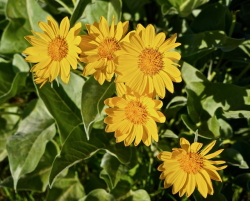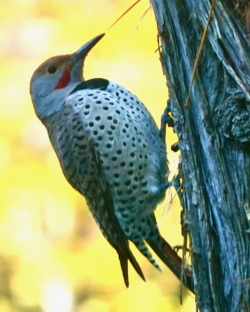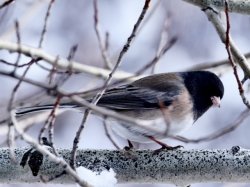
Courtesy US FWS, Peter Pearsall, Photographer
Native plants play an important role in an ecosystem, providing the best habitat for wildlife. They are species of plants that have grown naturally in an area and thrive in an environment that matches the soils, moisture, and weather of a particular locality.

Hyde Park, UT
Courtesy & Copyright Linda L’Ai
This data gathered by Audubon’s Plants for Birds Program supports the planting of native species whenever possible.
- 96% of land birds feed insects to their chicks.
- Native oak trees host over 530 species of caterpillars while non-native ginkgo trees host just 4.
- To raise one nest of chickadee babies, parents must gather between 6,000 and 9,000 caterpillars.
- Suburban yards planted with native species host 8 times more native birds.
Birds shape their migration patterns around native plants. Plants that produce fleshy fruit duirng the late summer and fall provide birds with the energy needed for long migrations.
Urbanization has resulted in a threat to native plants. According to Audubon, the continental United States has lost over 150 million acres of native habitat due to urban sprawl. Fragmentation of native plant habitat is believed to be due to the construction of cities, roads and river flow reservoirs. All of these, combined with a changing climate’s impact on timing of insect hatching and flowers opening, present many challenges to our birds.

Courtesy & Copyright Linda L’Ai

Courtesy & Copyright Linda L’Ai
The Wild plum, provides fleshy fruit for sparrows and chickadees and insects for woodpeckers.
Milkweeds attract hummingbirds and insect pollinators and serve as larval hosts for Monarch Butterflies.
Growing native plants is something we all can do in our yards or in the community to help bird populations increase now and in the future. Consider this: native plants that are adapted to the local region require less water, fertilizers and no pesticides.
Check out Audubon.org/plantsforbirds to find out more.
If you really dig birds, try digging native plants into your garden!
I’m Linda L’Ai with the Bridgerland Audubon Society, and I’m Wild About Utah!
Credits:
Photos: Courtesy US FWS, Peter Pearsall, Photographer, https://images.fws.gov/
Audio: Courtesy and Copyright Kevin Colver https://wildstore.wildsanctuary.com/collections/special-collections/kevin-colver
Text: Linda L’Ai, Bridgerland Audubon Society
Additional Reading: Lyle Bingham & Hilary Shughart, Bridgerland Audubon Society
Additional Reading
Grow Native For Birds, Bridgerland Audubon, https://bridgerlandaudubon.org/our-projects/grow-native-for-birds/
Plants For Birds, The Coleman and Susan Burke Center for Native Plants, National Audubon Society, https://www.audubon.org/plantsforbirds
“Plants for Birds,” National Audubon, https://vimeo.com/163864388
Native Plants for the Utah Landscape, Center for Water-Efficient Landscaping, Utah State University Extension, https://cwel.usu.edu/native-other
Native Plants, The Coleman and Susan Burke Center for Native Plants, National Audubon Society, https://www.audubon.org/native-plants/
Native Plant List-Utah and Western Colorado, PlantNative, Portland, OR, https://www.plantnative.org/rpl-ut.htm?fbclid=IwAR1nnlQUQ680x_SpwrKH_Fvtt2J2mtF7cqwZeUW8XAzzvlObs4K-kMPMIg0
Utah Native Plant Society, https://www.unps.org/
Tallamy, Doug, Sustainable Landscaping, Research, University of Delaware, May 2, 2013, 2.26 min, https://youtu.be/NTbPNwNIoLs
Tallamy, Doug, Eierman, Kim, EcoBeneficial Interview: Dr. Doug Tallamy In His Garden on the Importance of Native Plants, EcoBeneficial!, Nov 22, 2013, 29:30 min https://www.youtube.com/watch?v=w39g_f7BMUk
